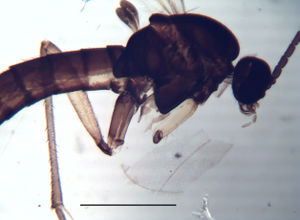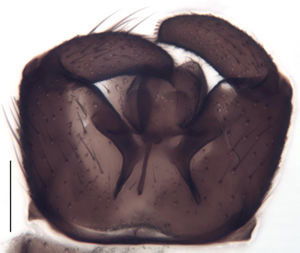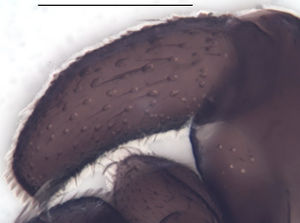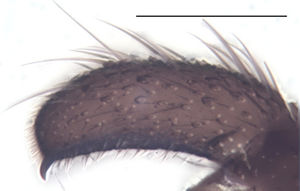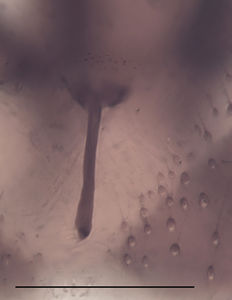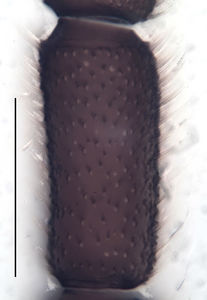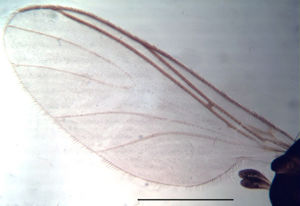Trichosiopsis intermedia
Ordo: Diptera
Familia: Sciaridae
Genus: Trichosiopsis
Name
Trichosiopsis intermedia unpublished
Type material
Holotype: ♂, 18.4.–2.5.2013, Malaise trap, leg. Rulik et al., ZFMK-TIS-2564686 in ZFMK
Type locality
Germany, Rhineland-Palatinate, Mayen-Koblenz, Winningen
Other material studied
Germany: 1 ♂, Baden-Württemberg, Bad Rotenfels, Bannwald Birkenkopf, Malaise trap, Doczkal, 16.9.-30.10.2003, PKHH 4635; 1 ♂, North-Rhine-Westphalia, Köln-Dünnwald, Kg. Grüner Kuhweg, Malaise trap, Franzen, 2.-09.05.1989, PKHH 1232; The Netherlands: 1 ♂, Tilburg, Kaaistoep, Malaise trap, v. Zuijlen, 25.4.-02.05.1998, PKHH 3768; 1 ♂, 2.-09.05.1998, PKHH 3764; Sweden: 1 ♂, Södermanland, Nämdö, Krokudden, Krokvik, spruce and pine forest, Malaise trap, Swedish Malaise Trap Project, 5.7.-07.08.2008, NHRS 4245; 2 ♂, 10.4.-23.05.2009, NHRS 4701/4702; 1 ♂, 23.5.-29.07.2009, NHRS 5165.
Description (male)
Head. Eye bridge 5–6 rows of facets. Antenna unicolour. LW-index of 4th flagellomere 1.95–2.3; neck 0.18–0.28 × segment width; transition of basal part to neck pronounced. Colour of neck unicolour. Antennal setae shorter than segment width; fine; dense; salient. Palpus darkened; long; palpomeres 3. First palpomere elongate; with 6–8 setae; with only sparse sensilla. Second palpomere elongate. Third palpomere as long as first. Thorax. Colour brown. Notum unicolour. Thoracic setae long and strong; of different colours. Posterior pronotum setose. Postpronotal setae 4–7; fine. Mesothoracic sclerites bare. Legs. Colour yellow, or yellow-brown. Hind coxa darkened. Setae on front coxa pale. Front tibial organ as patch of setae; pale; front tibial organ not bordered. Tibial setae on hind legs normal, shorter than tibial width. Tibial spurs of equal length. Claws untoothed. Wing. Wing hyaline, or slightly darkened; with conspicuous anal lobe, or of normal shape. Wing membrane without macrotrichia. Wing venation weak, with faint stM. M-fork of normal shape. R1 ending at or slightly before base of m-fork; posterior veins with macrotrichia; stM mostly with macrotrichia; CuA1 and CuA2 mostly with macrotrichia; bM setose; r-m mostly setose; bM:r-M 1.18–1.3; st-Cu:bM 0.35–0.55; R1:R 1.13–1.4; c:w 0.61–0.71. Halter darkened; of normal length. Abdomen. Abdominal setae strong; dense; on tergites dark and pale; on sternites white. Hypopygium concolour with abdomen; LW-index 0.5–0.7. Base of gonocoxites with weak setae; gonocoxites broadly separated; inner margin of gonocoxites typically U-shaped; inner membrane of hypopygium densely setose; ventral margin of gonocoxite with short setae. Gonostylus elongate; LW-index 2.7–2.96; Inner margin concave; apex equally rounded. Apical tooth present; without internal structure; of medium strength; LW-Index 2.2–3. Awl-like setae normal; present beneath apical tooth. Megasetae absent. Whiplash-hair absent. Tegmen 0.55–0.7 × longer than broad; rectangular with rounded edges; without special features; central process absent. Length of ejaculatory apodeme/hypopygium 27–37 %; base of ejaculatory apodeme present. Field with aedeagal teeth inconspicuous. Measurements. Body size 3.2–4 mm. Hind tibia 1.65–1.85 mm. Wing length 3–3.9 mm.
Diagnosis
Tr. intermedia belongs to the Trichosiopsis trochanterata complex, characterized by an elongate, tapered gonostylus and partly bright body hairs. It is similar to Tr. trochanterata and Trichosiopsis extra by the yellow legs. However, the setae at the hind tibia are not so conspicuous as in Tr. trochanterata, mid and hind coxae are darkened. In this respect it is more similar to Tr. extra, which is smaller and has a less elongate gonostylus. One distinguishing character to all other species of the complex is the dense setosity on the inner membrane of the hypopygium.
DNA Barcoding
The COI sequences are assigned to two different BINs:
- BIN BOLD:ACE2216 (average distance 0.26%, max. 0.96%, n=12, K2P: 4.49%)
- BIN BOLD:ADG4436 (n=1, K2P: 4.82%)
Etymology
The species got its name for being intermediate in colouration between Tr. trochanterata and Trichosiopsis saltuum.
Discussion
Trichosiopsis intermedia is another species which was or would have been regarded as belonging to a very variable species Tr. trochanterata. However, the constant differences in colour and the huge genetic distance of nearly 10% prove its distinctness. One single female with a divergent genetic barcode is regarded as belonging to a different subspecies.
Distribution
France, Germany, Netherlands, Sweden.
Notes
The records from “Kaaistoep” (Netherlands) were formerly misidentified as Leptosciarella trochanterata and published as such by Heller (2011)[1].
Subspecies list
Trichosiopsis intermedia intermedia - Trichosiopsis intermedia rugiana
Images
|
References
- ↑ Heller, K. 2011: Sciaridae (Diptera: Sciaroidea) aus dem Naturreservat „De Kaaistoep“, Niederlande. Studia dipterologica, 17(1–2), 172–176.
